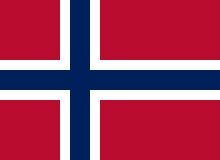Norwegian heavy metal
| Music of Norway | |
|---|---|
 |
|
| Media and performance | |
| Music charts | VG-lista |
Norway is a rather sparsely populated country in Europe (5 million inhabitants in an area of some 324,000 km2 (125,097 sq mi) excluding Svalbard and Jan-Mayen), but even so its music and its musical life are as complex as those of most other countries. Much has been learned about early music in Norway from physical artifacts found during archaeological digs. These include instruments such as the lur. Viking and medieval sagas also describe musical activity, as do the accounts of priests and pilgrims from all over Europe coming to visit St Olaf's grave in Trondheim.
In the later part of the 19th century, Norway experienced economic growth leading to greater industrialization and urbanization. More music was established in the cities, and opera performances and symphony concerts were considered to be of high standards. In this era both prominent composers (like Edvard Grieg and Johan Svendsen) and performers combined the European traditions with Norwegian tones.
The import of music and musicians for dance and entertainment increased, and this continued in the 20th century, even more so when gramophone records and radio became common. In the last half of the 20th century, Norway, like many other countries in the world, underwent a roots revival that saw indigenous music being revived.
Before 1840, there were limited written sources of folk music in Norway. Originally these historical attainments were believed to have a distinct Christian influence. As research continued, there was also mythical and fairy tale connections to the folk music. Overall the purpose of folk music was for entertainment and dancing.
Norwegian folk music may be divided into two categories: instrumental and vocal. As a rule instrumental folk music is dance music (slåtter). Norwegian folk dances are social dances and usually performed by couples, although there are a number of solo dances as well, such as the halling. Norway has very little of the ceremonial dance characteristic of other cultures. Dance melodies may be broken down into two types: two-beat and three-beat dances. The former are called halling, gangar or rull, whereas the latter are springar or springleik.
Traditional dances are normally referred to as bygdedans (village or regional dance). These dances, sometimes called "courting dances" were often connected to the important events of rural (farming) life: weddings, funerals and cyclical feasts like Christmas.
...
Wikipedia
